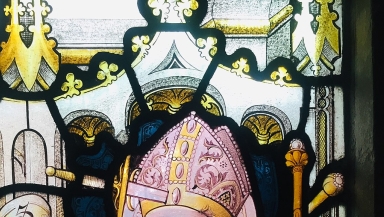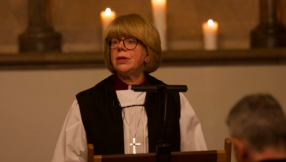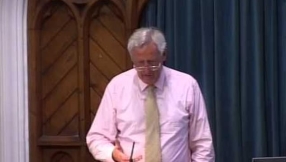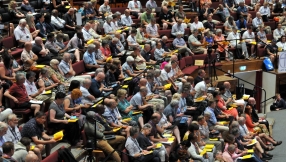
Murder in the cathedral
December 29th is the 850th anniversary of the death of Thomas Becket in 1170. To have the Archbishop of Canterbury murdered in his own cathedral would have been shocking enough. But in this case, those who committed the crime were convinced they were doing the will of their king, Henry II. In the dark of a winter's evening, as a service was underway, a group of armed men burst into the cathedral shouting "Royal Knights! King's men!" The situation exploded. They called Becket "traitor". He called one of them a "pimp"!
A violent altercation ended with swung swords and the top of the archbishop's head being sliced away. There is even a report that one of the killers thrust his sword tip into the open skull and declared "This man won't get up again!" The archbishop's brains were scattered across the floor. How did it ever come to this?
Church and state
During the twelfth century a controversy accelerated over the independence of the Church in western Christian nations. On one side, the Church believed that clergy should not be tried in royal courts, even for serious crimes. Instead, they should only face justice in church courts, under 'Canon Law'. In church courts, punishments were much lighter than in royal courts and monarchs resented the protection this offered to those accused of serious crimes.
This privilege was enjoyed by a lot of people. This was because there was a broad definition of what constituted being a member of the clergy. Any educated person (and the Church controlled education) who received a tonsure (a special haircut) as a mark of their status was technically a member of the clergy. As a result, anyone accused of a crime could claim what was called 'benefit of clergy' by reciting, in Latin, the words of Psalm 51:1 "Have mercy on me, O God, according to your unfailing love; according to your great compassion blot out my transgressions" (NIV). This, unsurprisingly, became known as the 'neck verse'. A lot hung (literally) on the ability to recite it.
On the other hand, church authorities resented the way that rulers put their friends and allies into key jobs, regardless of their suitability and level of faith. The answer, it seemed, was to reduce the power that rulers had over the Church. A battle was brewing.
When a friend became an enemy
Thomas Becket was the chancellor and friend of King Henry II. Henry was immensely powerful and his 'Angevin', or 'Plantagenet', empire stretched from the border with Scotland to the Pyrenees. It included half of France. He was a major European ruler; reinvigorated royal government and the rule of law in England; stamped his authority on troublesome nobles; and strove to resist papal influence, in order to strengthen his own authority in the Church within his realm.
To this end, he engineered the appointment of Thomas to the post of Archbishop of Canterbury in 1162. He clearly thought that the two of them would continue to work closely together. It turned out to be a huge miscalculation.
Thomas changed from energetic royal servant to single-minded defender of Church independence. This accompanied a total change of lifestyle. He now adopted ascetic habits and, allegedly, even wore a hair shirt. The dramatic change totally wrong-footed Henry.
Both men dug their heels in. The energy that Becket had once put at Henry's disposal he now deployed against him. Henry was bitter at what he felt was ingratitude and a betrayal of friendship; and Thomas was, arguably, unbending and high-handed in upholding his rights and those of the Church. Becket was exiled and he retaliated by excommunicating Henry's supporters, including clerics who had usurped his role by officiating at the coronation of Henry's son. After a ten-year-long dispute, Becket finally returned to England only to reignite the conflict again. Henry, allegedly, demanded "Will no one rid me of this turbulent priest?" And by the end of the year Becket was dead.
Holy martyr, or stubborn contrarian with a death-wish?
The official Church position was clear: Becket was a martyr. Miracles were attributed to him. People flocked to his shrine. In 1172, Henry negotiated a settlement with the pope. In 1173, Becket was canonized. In 1174, the king performed acts of public penance and humiliation at Becket's tomb. In reality, little changed and Henry continued to exercise his rights to make Church appointments. However, the controversial matter of clerical immunity from secular justice rumbled on for the rest of the Middle Ages. In 1220, Becket's remains were relocated from his first tomb to a shrine in the recently completed Trinity Chapel. This became one of the most visited pilgrim sites in England.
Becket was complex. A number of historians feel that Becket, once set on his course of conflict with Henry and rigidly certain of his rights, courted conflict and, in effect, finally encouraged his own martyrdom. What is clearer is that he died for a cause – the immunity of clerics from secular justice – which in large part would not find supporters today. Yet at the time he was a hero of the Church. It is a reminder that, in the words of the novelist L.P. Hartley: "The past is a foreign country; they do things differently there."
Martyn Whittock is a Licensed Lay Minister in the Church of England and taught history for thirty-five years in UK comprehensive schools. His published works, with a medieval theme, include: A Brief History of Life in the Middle Ages, the co-written The Vikings: from Odin to Christ, and three historical novels set in the Middle Ages. His co-written book, Christ: the first 2000 years, includes exploration of medieval beliefs in the development of Christology.













